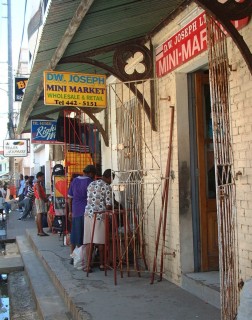
Typical Grenadian street scene
|
Caribbean Landfalls Windward Is. Pages Related Pages Caribbean ProvisionsWest Indies Flora & Fauna |
Grenada
See a larger map of Grenada |
| Language: | English |
| Population: | About 100,000 |
| Money: | EC dollar (tied at US $1 to 2.70EC$ or 1EC$ = US$ 0.37) |
| Landscape: | Lush, volcanic mountains. |
| Visited: | We stopped in Grenada from July 10‑16 to pick up John & Becky, then from August 9‑19, picking up Casey & Kenny, and finally from August 26‑Sept 16 doing boat work. |
| Track Files: | See the bottom of this page |
History: Although the British first attempted to colonize Grenada in 1609, they were unsuccessful due to Carib raids, and the settlement was abandoned. In 1650, the French governor of Martinique 'purchased' Grenada for essentially nothing and colonized the island. The French and Caribs had ongoing skirmishes, and French troops were sent in to oust the Caribs. The Caribs were rounded up to the northern end of the island, where rather than submit to the Europeans, they all, men, women, and children, jumped over the coastal cliffs to their deaths.
 Typical Grenadian street scene |
With the Caribs gone, the French colony began to flourish until 1762, when British admiral Rodney captured the island. The island traded hands several more times until the Treaty of Paris gave the British control of the island. They maintained control until Grenada's independence. The remaining French settlers did rebel at one point, managing to execute the British governor and take control of one city, but the British navy subdued the rebellion and the island remained British until the country of Grenada became independent on February 7th 1974.
The first prime minister of Grenada was horrendously corrupt, and used secret police to silence opposition. On March 13th, 1979, the government was taken over in a bloodless coup. Maurice Bishop, the new prime minister, reinstated basic human rights and was in many ways a better leader. He was, however, somewhat communist, and when the Cubans offered to build an airport in Grenada, their proposal was accepted. Bishop eventually realized that the Cubans were not going to leave Grenada, and appealed to the USA for help. When he returned he was killed by radical members of his own party. Troops from the US and several Caribbean nations invaded Grenada and drove out the Cubans. However, the politics are still tumultuous.
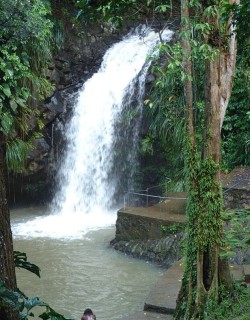 Anandale Falls, 1 of several visited |
(Amanda, age 13) What I liked most about Grenada is what we did inland, although while we were there there were also a lot of other teens, so that was a high point as well. The spice factory, rum distillery, Seven Sisters Falls, and, later, the nutmeg and chocolate factories were what we did inland, and I think all of them were done with at least one other sailing family with kids.
The Seven Sisters Falls I really liked, although the walk down through the forest was a killer on knees. The water was freezing, compared to the ocean, but it was refreshing and fun climbing up the cliff and jumping in. It would have been better if it had been hotter while we were there. Then we really would have wanted to go swimming.
The chocolate factory I really liked, especially because we bought some of their bars after the tour. You can read about the process at my excursions pages.
I liked being anchored in Prickly Bay, on the south end of Grenada, although the water wasn't very clear, and really deep. We had to anchor in about 30' (10m), and we only carry a little over 100 feet of chain. We usually like to anchor in about 7-20 feet of water. I didn't really want to leave Grenada -- that is, I didn't want to leave until suddenly I looked around and almost all our cruising friends had left, to Venezuela or Trinidad.
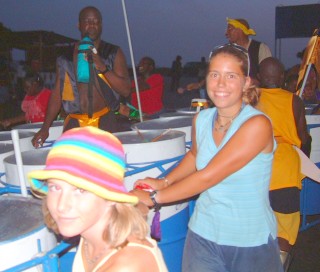 Amanda & Kat pushing steel drum bands through Grenada's streets at night |
So we stayed long enough to put up the radar and do several other things we needed to do before we got to Venezuela. As I've said before, we had really wanted to prop out the website again, but the urge to get down to Venezuela soon ruled that out.
(Chris, age 16) Grenada is called the spice island for good reason. The island is gorgeous, with beautiful waterfalls, pristine rainforest, and lush mountainsides. However, it seems that every other tree is cinnamon, clove, cocoa, some other spice, or (most commonly by far) nutmeg. Dominica may be the island where nobody starves, but Grenada must be the island where nobody has unseasoned food! Visiting Grenada's spice factories (including one just for nutmeg,) chocolate factories, and picking nutmeg and mace literally before you step on them, made our stay at Grenada quite unique. We also saw the Grenadan Carnival, a celebration which I have never seen the likes of before.
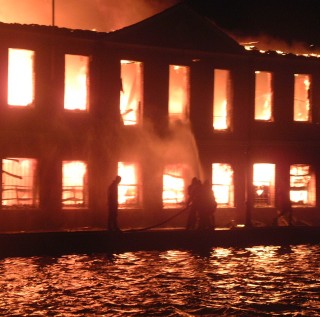 Few hoses were brought to bear, mostly manned by inexperienced civilians |
Grenada does have some troubles, however. Right after we dropped anchor here for the first time, there was a huge fire. It started in a hardware store right on the waterfront, and the fire station was right across the fairly small bay. In the US, it would have been no problem, but Grenadan fire departments don't quite seem to be up to American standards. One fire boat with a couple of water cannons could have arrived on time, pumped thousands of gallons of water out of the bay, and put the fire out in minutes. However, it was three hours before the fire department even got to the scene of the fire (though it is about a 2 minute drive). During that time, the first section of the hardware store's roof had collapsed, the second part was burning fiercely, and sparks were flying across the street to the public library. The fire eventually burned itself out, but it took much longer than it should have. In most other ways, however, Grenada is a wonderful place, and I quite enjoyed our time there.
(Jon) Before you go too far, you might want to read my thoughts about the October 1983 U.S. "intervention" in Grenada, because the press presented it all wrong, and the American people were denied the complete story, to America's detriment!
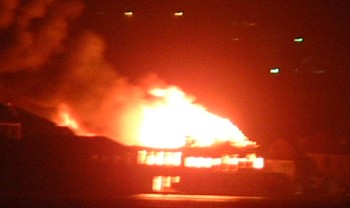 From Ocelot - The St. Georges waterfront burning! |
So here's a different situation (that Chris started, above) that might have been funny if the outcome weren't so sad. A real Keystone Kops operation.
We were anchored off St. Georges and I was sitting up late one night doing email, when I decided to go on deck for a stretch. I looked around from the cockpit and noticed that ... the waterfront of St. Georges was burning! Transfixed, I watched through the binoculars for 30 minutes or so, as the first roof crashed in and the next one over caught fire. Then I woke Christopher, dropped the dinghy in the water, and we motored into the Careenage to check it out.
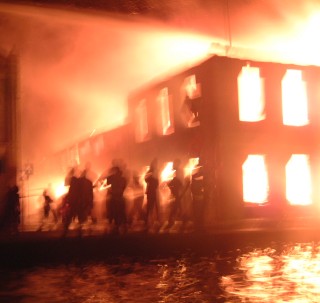 Pandemonium reigned at the St. Georges fire |
Pandemonium reigned. Crowds were everywhere, but policemen and guns outnumbered fire hoses. Five engines were present, three from the fire station (only 400 yards away) and two big foaming trucks from the airport (which quickly and ineffectually exhausted their foam). Only one fire engine was doing anything effectual. A truck with a cannon at the top of its ladder had stuck its snorkel into the lagoon (which was just across the street from the fire) and had just started spraying seawater - at least an hour after the fire had broken out. It managed to put out the fire under the eves of the old library across the street, for which I'm very grateful. Those books (and the building, almost 150 years old) are irreplaceable. But that was the only engine that ever did anything really useful.
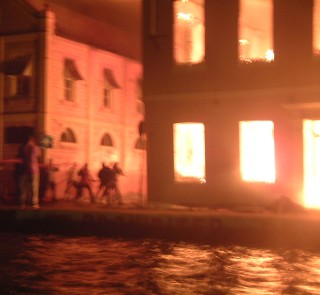 The Library, on the left, was saved |
Apparently (and this is quite hard to believe ) the donated (and quite new) fire engines didn't have the right fittings to connect to the fire hydrants. Some small pumps were brought up, to suck water from the lagoon, but apparently they couldn't be primed. It seemed that nobody had ever tried them. Chris and I stayed until about 2:30am and eventually saw one hose spraying, but by that time the whole block was burning, and the fire was much too big for 1 little hose. Undaunted, it sprayed on the fire for a while, then decided that the buildings across the street were getting hot, so it sprayed them down. This succeeded only in shattering all the windows, exposing the (flammable) interiors to the heat of the fire. Luckily, by this time, the entire block had pretty much burned down, and the fire didn't quite have the oomph to jump the street (although that side of the church at the top of the hill turned black from the smoke). In all, a hardware store, furniture store, appliance store, and Rudolph's Restaurant (an icon, which had stood there for about 20 years) were all lost, and the entire block was reduced to rubble.
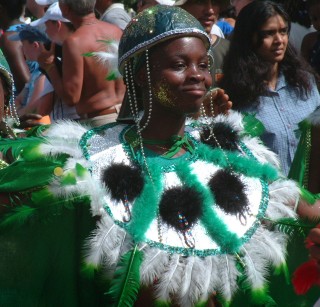 One of many happy dancers, all in the finest (sometimes craziest) Carnival costumes |
So what went wrong? The clue is the fire station. It's bright pink - including the practice tower out back. Obviously, it had never been used for real practice. In My Humble Opinion, the fire chief was completely incompetent and should have been removed with the rubble of Rudolph's Restaurant, to be replaced with someone who could at least find his butt with both hands, but perhaps I don't know the entire story...
(Sue) We've been in and around Grenada for 2 months now, so after St. Martin, it is our second "home' in the Caribbean, followed by the month we spent in Dominica. Strange how this all worked out -- I would have anticipated spending more time in Martinique and less in Grenada and Dominica. But that's cruising life. No real plans, and those that we make are subject to change.
I think Grenada's main appeal is that it is friendly, easy to get around, and relatively safe. My favorite anchorage here was off the capital of St. George's, where the water is clear and the downtown is a short dinghy ride away. We did spend a lot of time though in the southern anchorage of Prickly Bay. Here we had access to Internet, Friday night steel bands, a good dinghy dock, and lots of other cruising friends. The kids all spend the hot (and it was hot and humid) afternoons swimming off the boats or, for a while, off a local private dock. For several weeks in the summer we had up to 10 teens who hung out together.
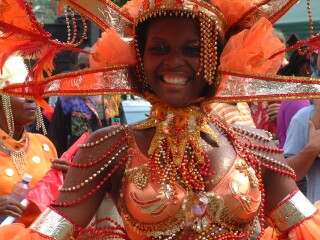 Impressive costumes lead each parade |
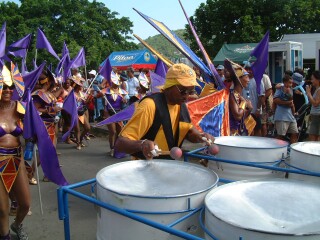 Steel bands and brightly costumed parades |
Carnival (August 6 to 12) was a riot of color and noise (I hate to grant it all the status of music). The whole event took place over a week or more, but it ran on island time, meaning you could never count on anything starting on the day it was slated for, and certainly not the hour. We often went with other yachties into St. George's by bus and walked the streets for hours taking in the parades, steel bands, and wild costumes.
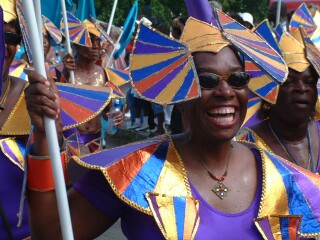 Carnival parades often feature lots of wild costumes |
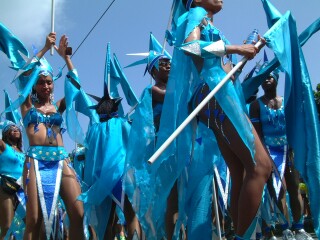 Some costumes & dancing were quite blatant |
The most surprising thing was the blatant sexuality of the costumes and dancing. Even with kids as young as 7 or 8. Never would fly in the US. The most memorable time was helping to push a steel drum band on wheels up and down the streets late one night. Good fun.
Cruisers: We are now publishing Downloadable Track Files in OpenCPN (.gpx) format and in MaxSea (.ptf) format (not all tracks are available in all formats yet - we're still working on it and they take time). You can download the track files either by clicking on the links in the tables below, or by clicking on the track in the Google Map below the table. The MaxSea files are in native format but the OpenCPN files are zipped so they download faster, and they need unzipping after they've been downloaded (which most operating systems do natively). If 2 files are shown, the smaller one has been edited to remove redundant points from straight tracks. This improves the speed of the download as well as performance once the file is loaded. Sometimes MaxSea Track files are separated from the Mark (chart notations) files. Download instructions are provided if you need them.
These files are provided free and we are actively soliciting cruisers to send us your track files so we can post them for others to download. If you would like to to participate, please email us your track files (as attachments to our HackingFamily account, not our Winlink acct) along with your boat name and draft. If you include your website and boat details, we'll link back to you from our Cruising Links page.
Disclaimer: While we always try to provide useful information, we can take no responsibility for its accuracy or usefulness. Prudent mariners will always navigate using all means at their disposal, and will not rely solely on electronic navigation.
Southeast Caribbean Sailing Tracks
| Boat | Draft | Year | Comments | MaxSea | OpenCPN |
| Taniwani | 6.6' (2m) | 2005 | Grenadines | 12 KB | 6 KB |
Windwards:
Related Pages: Chris Spice Factory | Amanda Chocolate Factory | Amanda Nutmeg Factory | 1983 U.S. Intervention in Grenada
Caribbean:
Top Level: Home | Destinations | Cruising Info | Underwater | Boat Guests | Ocelot | Sue | Jon | Amanda | Chris | Site Map | Make a Comment
|
If our information is useful, you can help by making a donation |
Copyright © 2000‑ Contact: Jon and Sue Hacking -- HackingFamily.com, svOcelot.com. All rights reserved.